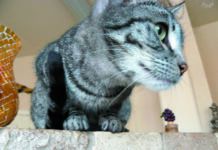Polycystic kidney disease (PKD) is a slowly progressive and inherited kidney disorder that affects Persian and Persian-related breeds, and it is the most prevalent inherited genetic disease in cats. The prevalence of PKD varies by country, ranging from 36 percent (Slovenia) to 49.2 percent (United Kingdom). In the United States, 38 percent of Persian and Persian-related cats have the condition.
PKD shows up early
Although most cats will eventually develop signs of kidney disease as they age, cats with PKD experience the signs of chronic kidney disease (CKD) at an earlier stage in life. Typically, cats begin to show the first signs of CKD around the age of 13 or 14 years. Cats with PKD, on average, will develop signs of CKD around seven years of age.
The job of the kidneys is to filter toxins from the bloodstream and eliminate them in the urine. As cats age, normal kidney tissue is slowly replaced by scar tissue, and the kidneys gradually become less effective at filtering. As the scar tissue contracts, the kidneys become progressively smaller in size. The kidneys of cats that are affected by PKD also gradually lose their ability to filter — however, the kidneys of these cats become enlarged rather than smaller. This is due to the existence of multiple cysts (hence the “polycystic” in the name) that are present in both kidneys at birth.
The cysts grow slowly over time, causing the kidneys to become enlarged. These cysts compress the kidney tissue surrounding them, reducing their function. The cysts can vary in size from less than 1 mm to greater than 1 cm. Because the cysts enlarge over time, older cats will have larger cysts. Cats with PKD occasionally will develop cysts in the liver as well (although this has no clinical consequence).
The signs of CKD in cats include increased thirst and urination, poor appetite, weight loss, vomiting and lethargy. Blood and urine tests will confirm that a cat has chronic kidney disease, but they are not able to establish that PKD is the underlying cause. Late in the course of the disease, the veterinarian may be able to detect enlarged, irregular kidneys by feeling the abdomen of a Persian or Persian-related cat, suggesting that PKD is present.
Ultrasound as diagnosis
However, the cysts are not detectable on physical examination in the early stages of the disease. Therefore, to make a diagnosis of PKD early in the course of a cat’s life, a diagnostic imaging procedure will need to be employed — with ultrasound considered to be the most sensitive and non-invasive technique for this.
Ultrasound has the potential to detect PKD as early as six to eight weeks of age. (In some instances, cysts have been detected in kittens as young as four weeks old.) In the hands of an experienced ultrasonographer, PKD can be diagnosed with approximately 75 percent sensitivity in cats less than 16 weeks of age. This increases to 91 percent sensitivity in affected cats at 36 weeks of age (because, by then, the cysts may be larger and easier to detect).
An autosomal dominant trait
In Persian cats, PKD is inherited as an “autosomal dominant” trait. This means that if a cat with PKD is bred to a normal cat, 50 percent of the offspring will develop PKD. Because kidney disease resulting from PKD develops later in life, an affected cat may have produced a large number of kittens before he or she becomes ill from PKD itself.
Fortunately, PKD can now be diagnosed via genetic testing. The test requires submitting a cheek swab or a blood sample to an appropriate testing facility. Cats of any age can be tested by this method. However, when testing kittens that have not yet been weaned, a blood sample is necessary. Because nursing kittens will have traces of the mother cat’s DNA in their mouths, this can lead to inaccurate results if a cheek swab is used. The genetic test accurately identifies all cats carrying the abnormal gene.
Ask for negative screening
Early identification of PKD — whether through ultrasound or genetic testing — is helpful because it allows the detection of the disorder before cats are bred. If all affected cats were neutered and spayed once the disorder is detected, PKD could be eliminated completely from breeding populations. Anyone planning to purchase a Persian kitten from a breeder should ask the breeder to provide proof that the cats used to produce the kitten were screened as negative.
Currently, there is no treatment for PKD. Treatment of the chronic kidney disease that results from PKD is similar to treating CKD that results from the natural aging process. This may include subcutaneous fluid administration, potassium supplementation, phosphorus binders, anti-nausea medications, appetite stimulants, drugs to control elevated blood pressure, drugs to reduce excessive protein loss in the urine and the feeding of prescription diets that contain reduced levels of protein and phosphorus.
Although there is no specific treatment for PKD, the presence of PKD can be reliably demonstrated by ultrasound in an older cat, or via genetic testing at any age. If breeders responsibly remove all affected cats from their breeding stock, it should be possible to eradicate the disease from the breed. — Arnold Plotnick, DVM, DACVIM



